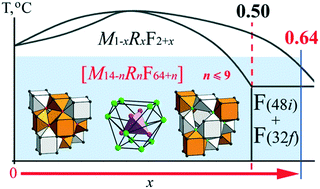The universal defect cluster architecture of fluorite-type nanostructured crystals
Abstract
A universal cluster model (UCM) of a defect (cluster) structure was developed on examples of nanostructured nonstoichiometric crystals (NNCs) M1−xRxF2+x (M = Ca, Sr, Ba; R = La–Lu, Y) of the fluorite type (CaF2). This family of NNCs consists of 48 phases of different elemental (M, R) compositions. Their RF3 content reaches 50 ± 3 mol%. Crystal matrices MF2 and RF3 control the cluster structure and properties of the NNCs. They are components of MF2–RF3 systems in which these NNCs are formed. The UCM was created on the basis of the studied structures of the ordered phases M4R3F17 (M = Sr, Ba) and M2RF7 (M = Ca) and the mineral tveitite Ca14Y5F43 with a structure derived from the CaF2 type. Clusters [M8R6F68–70] are the structural units in them. The M4R3F17 architecture was first presented as an assembly of blocks of MF2 matrix structure and blocks of both types of structures of the second system components: LaF3 [R6F44] and β-YF3 [R6F40]. Rare-earth clusters in MF2 matrices are treated as nanoscale blocks (R-enriched “nanophases”). The model is based on the octa-cubic cluster [M14−xRxF64+x] with the cuboctahedral anionic core {F12}. The new model describes the structure of M1−xRxF2+x with all M and R and any x. The UCM is of fundamental interest for the most common nonstoichiometry in inorganic fluorides of the CaF2 structural type. The properties of fluorite-type NNCs are controlled by a defect structure, which allows them to be used in quantum electronics, optics, solid state ionics, photonics, in vivo deep-tissue bioimaging NaRF4:(R' + R′′) and other fields.



 Please wait while we load your content...
Please wait while we load your content...